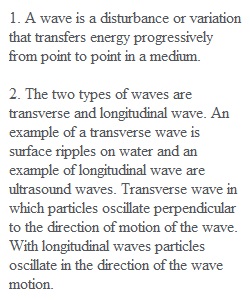


Q This assignment aligns with the following Unit Objectives: • (U62) Define waves (CLO2) • (U64) Discuss the differences in various types of waves (CLO2)(CLO3) • (U66) Discuss the terms used to describe waves: wavelength, frequency, velocity. (CLO2)(CLO3) • (U67) Discuss the interaction of waves and matter (CLO2)(CLO3) • (UDS) Develop a well thought out and correct response to various discussion questions (CLO2)(CLO3)(CLO5)(Goal 4) Do not start a new thread. Simply reply to my posting. Be sure to comment on at least two of your classmates' postings. Your replies must be more than a simple phrase like "I agree" or "I like your answers". Replies should reflect why you agree or like what has been posted. Your replies must reflect a genuine effort to engage your fellow classmates regarding the comments provided or the problem that has been solved. Please post your answers and replies to the discussion questions below 1. What is a wave? 2. What are the two types of waves? What are the parts of each type of wave? How are the types of waves different and alike? Give examples of each type of wave. 3. What is the relationship between frequency and period? What are the SI units for each? 4. Which material does sound move faster through lead or water? 5. What is resonance?
View Related Questions